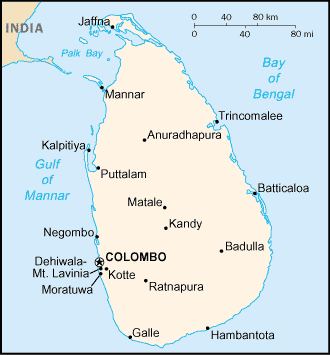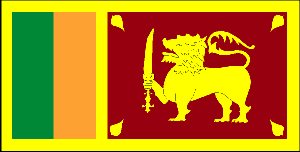
|
Sri Lanka
Background:
Occupied by the Portuguese in the 16th century and the Dutch in the 17th
century, the island was ceded to the British in 1802. As Ceylon it became
independent in 1948; its name was changed in 1972. Tensions between the
Sinhalese majority and Tamil separatists erupted in violence in the mid-1980s.
Tens of thousands have died in an ethnic war that continues to fester.
Location:
Southern Asia, island in the Indian Ocean, south of India.
Area: Total: 65,610 sq km, water: 870 sq km, land: 64,740 sq km.
Area - comparative: Slightly larger than West Virginia.
Coastline: 1,340 km.
Climate and Terrain:
Climate: Tropical monsoon; northeast monsoon (December to March); southwest
monsoon (June to October).
Terrain: Mostly low, flat to rolling plain; mountains in south-central
interior.
Natural resources: Limestone, graphite, mineral sands, gems, phosphates, clay,
hydropower
People:
Population: 19,576,783.
Ethnic groups: Sinhalese 74%, Tamil 18%, Moor 7%, Burgher, Malay, and Vedda 1%.
Religions: Buddhist 70%, Hindu 15%, Christian 8%, Muslim 7%.
Languages: Sinhala (official and national language) 74%, Tamil (national
language) 18%, other 8%, note: English is commonly used in government and is
spoken competently by about 10% of the population.
Government:
Government type: Republic.
Capital: Colombo; note - Sri Jayewardenepura Kotte is the legislative capital.
Independence: 4 February 1948 (from UK).
Economy overview:
In 1977, Colombo abandoned statist economic policies and its import
substitution trade policy for market-oriented policies and export-oriented
trade. Sri Lanka's most dynamic sectors now are food processing, textiles and
apparel, food and beverages, telecommunications, and insurance and banking. By
1996 plantation crops made up only 20% of exports (compared with 93% in 1970),
while textiles and garments accounted for 63%. GDP grew at an average annual
rate of 5.5% throughout the 1990s until a drought and a deteriorating security
situation lowered growth to 3.8% in 1996. The economy rebounded in 1997-2000
with average growth of 5.3%. But 2001 saw the first contraction in the
country's history, due to a combination of power shortages, severe budgetary
problems, the global slowdown, and continuing civil strife.
GDP - composition by sector: Agriculture: 21%, industry: 27%, services: 52%.
Statistics:
Telephones - main lines in use: 494,509.
Telephones - mobile cellular: 228,604.
Radio broadcast stations: AM 26, FM 45, shortwave 1.
Radios: 3.85 million.
Television broadcast stations: 21.
Televisions: 1.53 million.
Internet users: 121,500.
Railways: Total: 1,463 km.
Highways: Total: 11,285 km, paved: 10,721 km, unpaved: 564 km.
Airports: 15, with paved runways: 14, with unpaved runways: 1.
Return to Visiting Locations
|

